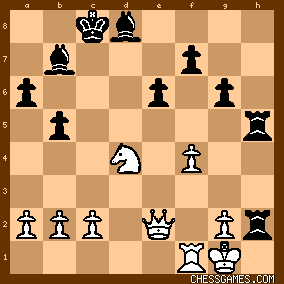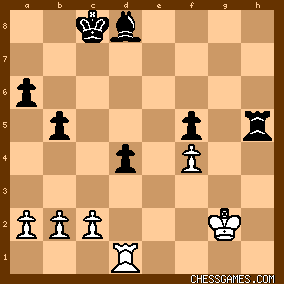|
< Earlier Kibitzing · PAGE 1 OF 4 ·
Later Kibitzing> |
| Oct-05-07 | | think: I got this puzzle! I almost never get fridays. The rook cannot be taken, as Bf2+ ends the game shortly. Otherwise, black doesn't have any appealing options. |
|
| Oct-05-07 | | beginner64: I got the first move, and considered g3 as the best response from white. I overlooked the rook check. |
|
| Oct-05-07 | | not yet a patzer: Okay, if black could move Bd4 he would have a winning position. (Qf2 Rh1#; Qe3 Bxe3 with mate to follow.)However, there are a knight and a rook defending that square. Bd5 blocks the rook and attacks the knight. IF white moves the knight (not likely) then Bd4 follows and wins. If white does NOT move the knight, then I suppose I would move Rg2+ and trade a rook and a bishop for the white queen. Black would still be down a piece but improved. Of course, I know, none of this has anything to do with the solution. Now I will see how miserably I failed. |
|
| Oct-05-07 | | not yet a patzer: Hey! I saw Bh4, but it blocks Rh8 so black cannot play Rh1#. Black did play Rg2 as I mentioned, and came out even on pieces because of the white rook sac? White's Rd8, is a great mystery to me. Eny he'p twood be 'preciated. |
|
Oct-05-07
 | | An Englishman: Good Evening: Got this one, another one of those "fall-out-of-the-chair" shots that had to stun the poor victim, although it does seem like rather a lot of effort to end up with just an extra pawn. |
|
| Oct-05-07 | | dzechiel: Black to move. Material decidedly uneven (black has a bishop for his queen). "Difficult". OK, the first idea I see is to set up a mating net using the dark square bishop to cover f2, and ultimately g1 and g3. For instance 25...Bh4
If 26 Kxh2 then 26...Bf2+, white tosses the queen to block the h-file and it's mate after 27...Rxh5#. Now, black, of course, is not required to take our rook on h2. But if he doesn't, the threat is 26...Rh1+ 27 Kxh1 Bf2+ and we are back in the mating business. So, how does white stop the mating combination started by 26...Rh1+ without taking the rook? To play 26 g3 takes the mate away (only for a moment), but drops the queen. It appears that white's best try is
26 Rd8+
The rook cannot be taken by 26...Rxd8 as that hangs the rook on h2. It can be taken by the bishop (26...Bxd8), but that seems to only get us near material equality (but we still have a powerful attack, so that might be the trick). It can also be taken by the king, but that allows 27 Qd3+. While this allows white to move the g-pawn, mates still abound, and I think that white's busted. I think that after 25...Bh4, white probably just resigns. Time to check. |
|
| Oct-05-07 | | beginner64: <not yet a patzer: White's Rd8, is a great mystery to me. Eny he'p twood be 'preciated.>
You probably already saw dzechiel's response. After Bh4, everything except Rd8 loses rather quickly (Even g3). |
|
| Oct-05-07 | | moppa: not yet a patzer: In the Bh4 line black can't play Rh1#, but threatens Rh1+ Kxh1 Bf2+ mating. One step backwards, two steps forward! I think I got this one, altough I thought Rd8+ would be desperate for white. beginner64: 26.g3 Rxe2 and black's a piece up (gxh4 Rg2+ Kh1 Rxh4#) |
|
| Oct-05-07 | | dzechiel: I guess there was some play in the position after all. I will be interested to see what <MAJ> has to say about the merits of 26...Kxd8. Does this really let white off the hook? |
|
| Oct-05-07 | | dzechiel: A pretty zugzwang finish to the game! At first I wondered why black didn't play 40...g5 (and this may still be winning), but white could respond with 41 f5 exf5 42 d5 and it just gets messy. 40...f5, although anti-positional (leaving yourself with backward pawns on the e- and g-files) leaves white with no good response. |
|
| Oct-05-07 | | lentil: Can anyone explain why black played 27. ... Bb6 instead of the (now) obvious 27. ...Bh5, reestablishing the mate threat? BTW, I got this one. After a few seconds, Bh5!! jumped out. The more impressive is that B must have seen this when he played 22...Qxd6. |
|
| Oct-05-07 | | Some call me Tim: Good puzzle but Black's attacking options are limited to finding a way to get the dark squared B to attack f2 so it seemed fairly narrow. Not easy but not a lot of options. Spent time making sure there was no other way to get the B on that diagonal. |
|
| Oct-05-07 | | not yet a patzer: Thanks <begginer64 and moppa> for your responses. After I posted, I saw the brilliance of Bh4 and the mate theme with Bf2 and Rh8. Rd8 looks like a desperation move, but it certainly did extend the game. |
|
| Oct-05-07 | | jheiner: I'm going to give myself credit for this one. I saw the key moves and suspected this would end in a pawn endgame, but missed Rd8? 25. ... Bh4 threatens 26. Kxh2 Bf2#. Isn't that "Greco's Mate", and didn't we have that exact mating pattern earlier on Mon/Tues this week or last. The problem to white now is 26. ... Rh1+ 27. Kxh1 Bf2#, as above, but now forced. 26. Rd3 would work, but for the light bishop pin on the g2 pawn: 26. ... Rh1+ 27. Kxh1 Bf2+ 28. Rh3 Rxh3#. 26. g3 hangs the Queen. 26. Rd8 hangs the rook, and now either way, Black can trade on g2 Queen + pawn for Rook + Bishop, and the endgame is Blacks. In the game, I was suprised by the Bishop Knight trade. I would trade off the Rooks quickly and play for the minor piece endgame, but Blacks ending is nice. |
|
| Oct-05-07 | | Some call me Tim: Another thought--The most amazing thing about this sequence is not Bh4 but the Q sac on move 22, which required Black to visualize the combination through 25...Bh4 and the follow up Rh1+. Very pretty. |
|
| Oct-05-07 | | DWINS: <dzechiel>, I submitted 26...Kxd8 to computer analysis and it does indeed appear to let White off the hook. 27.Qd3+ Ke7 28.Kxh2 Bf2+ 29.Qh3 Rxh3+ 30.Kxh3 and White is winning. |
|
| Oct-05-07 | | JohnTal: I concur Lentil - 27 ... Bh5 would have forced White resignation or White could delay an h-file mate by returning the Q after 28 g3. Perhaps, Black was fearful of 28 Nf3?
For example 28 g3 ...Bg3, 29 Qh2 ...Rh2 ensures a B advantage for
Black - even after White moves Kt or R to f3(blocking the scope of the b7 Bishop) to stop ...Rh1# I remain shocked that Black traded the Q for Kt on move 22, most of us would have played ...Kb8. Incredible confidence! After the move, ironic that White later had to return the piece and be Zugzwanged in 40 moves. |
|
| Oct-05-07 | | jheiner: Found it. Greco's Mate from just the other day.
Emms vs A Blees, 1996 |
|
| Oct-05-07 | | MostlyAverageJoe: <lentil: Can anyone explain why black played 27. ... Bb6 instead of the (now) obvious 27. ...Bh5, reestablishing the mate threat?> <JohnTal: I concur Lentil - 27 ... Bh5 would have forced White resignation> You mean 27...Bh4, right?
Because 28.Nf3 prevents the pretty mate starting with Rh1+ (see first post from <dzechiel>). I disqualified myself today - unlucky placement of the cursor over Recent Kibitzing on the main page has brought up a popup that started <not yet a patzer: Hey! I saw Bh4 ... >. Oh, well. At least I found the above refutation to 27...Bh4 before confirming with Hiarcs that 27...Bh4 indeed gives the advantage back to white. I am not sure that I would've solved this puzzle anyway. I suppose I might have looked at Bh4 after disqualifying 25...Rh1 and 25...R8h3, both of which look kinda plausible, but lead to nowhere. Or I might have run out of time. No way I'd find this OTB, but also no way I'd get there by sacrificing the queen. Quick computer analysis: I am not sure why black sacrificed his queen with 22...Qxd6, when the natural 22...Kb8 is just as good or slightly better, according to Hiarcs. Maybe there is some 'gotcha' after Kb8 that the quick analysis does not find, but I have no time to analyze it. Still, seeing the entire combination at the sac time (otherwise why sac it?) is mightily impressive. Also, the rest of the game might be inaccurate. Hiarcs likes 27...R8h5 much better (about 1 pawn worth) than 27...Bb6 that was played. But the line goes into wild combinations that again I have no time to pursue. The main threat there is e5, opening the f-file for the rook on the 5th rank. If anyone wants to have fun with this position (white to move): 
click for larger view then have a go at it. 28.Rd1 is supposed to be the best. The mainline is something like: 28. Rd1 e5 29. Qg4+ f5 30. Qxg6 Rxg2+ 31. Qxg2 Bxg2 32. Kxg2 exd4 and leads to a clear win: 
click for larger viewbut why the other white's moves fail even worse is not quite clear without spending a lot of time. |
|
| Oct-05-07 | | White Star: how does Black continue after 25) Rf3...? |
|
| Oct-05-07 | | beginner64: <dzechiel: A pretty zugzwang finish to the game>
Absolutely agree.
I noticed it too that the intuitive g5 leads to a bit messier situation (though still winning). f5 forces white to play b3, which is of course met with a3. |
|
| Oct-05-07 | | MostlyAverageJoe: <White Star: how does Black continue after 25) Rf3...?> Calls the tournament director and complains about an illegal move :-) After 26.Rf3, mate in 3, starting with Rh1+ (see earlier posts, note that g2 is pinned). |
|
| Oct-05-07 | | MostlyAverageJoe: <not yet a patzer> and <moppa> Rd8+ is not really a desperation move - it gains a tempo that white is sorely missing (and can use, e.g., to play Nf3 mentioned in my first post). BTW, if not Rd8, then the second best move for white is to give up the queen and take out the dangerous bishop with 26.g3. Still, one tempo is not enough. Even white could get a couple of extra moves, e.g.: 26. Rd8+ Bxd8
27. Nd4 <skip>
28. a4 <skip>
29. axb5 axb5
30. Rd1 <skip>
31. Kf1 Bxg2
black seems to be STILL winning :-)
|
|
Oct-05-07
 | | Richard Taylor: I solved this - very ingenious. |
|
| Oct-05-07 | | Confuse: got the first step only. cool game! |
|
 |
 |
|
< Earlier Kibitzing · PAGE 1 OF 4 ·
Later Kibitzing> |





